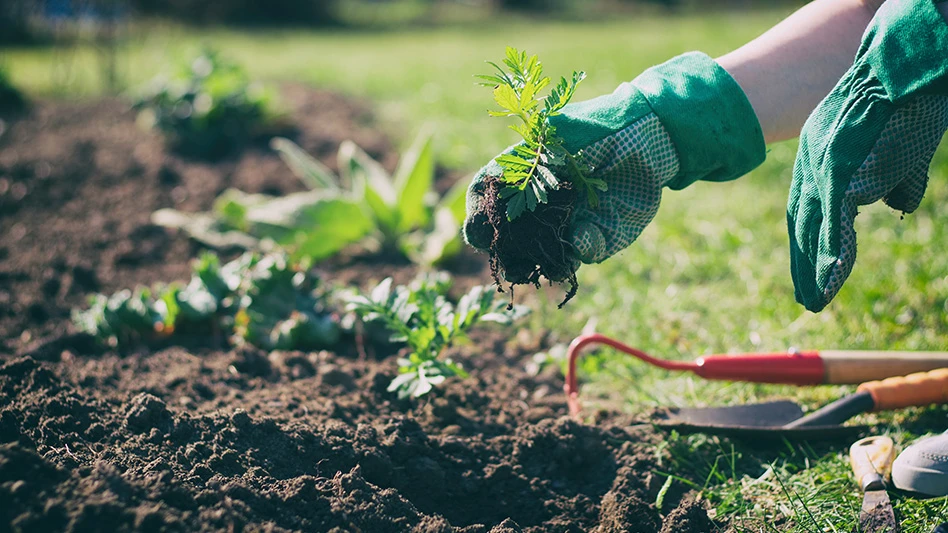
Over the last 20 years, the plant tag has gone from a way for the grower to label the product to a way for the consumer to gather information on the product of purchasing. Tags and labels are now about consumer information, why the consumer should buy that product, care and pricing at the point of purchase. Rick Vulgamott, national director of sales for the horticulture division of WestRock, says tags and labels excel in their role as a silent salesperson.
“One way to help make sure the customer feels a little more comfortable about buying the product is to support their buying decision with features and ‘why buys’ right there at eye level on the plant,” he says.
Bob Lovejoy, president of Hip Labels, shares a story from a recent meeting with the manager of a South Carolina garden center that purchases tags from his company.
“She said, ‘Bob, when we’re busy; 90% of the customers in here don’t get to see somebody face to face. And the plants with tags sell much better, much easier. If there’s no tag on it, people just walk away from it. They don’t know what to do with it.’ So at least in that one situation, the retailer realizes how much value a tag adds to the sales process.”
Lovejoy says that branded tags are playing a huge role in the tags and labels industry — much more than they were 10 years ago. And the reason that’s changed is the consumers themselves are more receptive to branding. Millennials that “finally got up the guts to go to a garden center” are not as price-driven as earlier generations.
“They’re not going to buy a plant for a dollar or two,” he says. “They’re going to buy the plant that looks the best. It has the best instructions and that bodes very well for the branded products.”
In addition to its standard hang tags and stake tags, Hip Labels makes custom pot wraps that are popular with branded plants.
The essential info
What should be on a tag? There are a few things that can help that plant sell itself. Instead of simple care requirements, you want to give the consumer reasons to buy that plant. If it attracts butterflies, or it’s drought-tolerant or deer-resistant, put that on the tag.
Vulgamott says at WestRock, they’ve moved away from information about what not to do. Opt for information that entices the consumer to make a purchase, not warnings that will make them think caring for this plant will be too challenging, which end up driving them to spend their money on something else.
Icons are easily-recognizable images used to present care information: for example, full sun, or shade. They can also be used to detail how much water a plant needs or what its size and shape will be at maturity. WestRock uses icons on almost every tag or label they produce, Vulgamott says.
“It’s our version of a plant emoji,” he says. “People recognize emojis; they therefore recognize icons. Space is limited on a tag or label. So we really have to concisely put the appropriate information on there that the consumer feels comfortable with and will see quickly.”
Tags and labels are just one part of WestRock’s business. The company manufactures POP, along with corrugated packaging, which includes shippers, displays and adhesives all in-house. The point-of-purchase material provides helpful info that sells more plants.


The new gardeners who purchased plants online during the COVID-19 pandemic will need help keeping their purchases alive, and that’s where the tag comes in.
“Our customers are shipping plants to people who can’t spell plant,” Lovejoy says. “They have no idea what they’re buying. They want to have to have it in their apartment or condo, just because it’s cool.”
Lovejoy says these online purchases should be accompanied by not only an informational tag, but growers and retailers should use it as an opportunity to talk about the company plant was purchased from and why you should buy your next plant from them, too.
Innovations in automation
The printing and application of tags and labels is all on the grower’s shoulders. Typically, a retailer will direct the grower to use a label or tags in conjunction with labels. It used to be common to use a tag to convey information to the consumer and a blank white adhesive label with black print to communicate the UPC and price point. They were separate items applied separately.
As labor became a bigger issue, growers needed to find a way to minimize the number of touches to the plant. At the same time, retailers wanted all the information on one component.
“Everybody’s having labor problems and labor costs are just getting out of hand,” says Tony Cook, CEO of Great Lakes Label, the owners and creators of the Label Gator brand of products.
Cook says he’s seen facilities with 50 people applying labels by hand. When it comes to tagging, it’s not abnormal to see eight or nine people per production line handling tagging to keep up with run rates of the other equipment.
The biggest complaint he hears from growers is a lack of labor to tag plants during the production process. And handling the inventory in the tag room is quite a job itself.
“Those (tags) don’t just get to the line themselves,” Cook says.
“So they create a make-work program where people are running around trying to get the right tags to the right line.”
There’s also the minimum order question. Many growers have pallets and pallets of boxes of different tags that they can’t use.
“Every grower has at least a 30% obsolescence rate in tags because they have to buy a minimum of a thousand of everything,” Cook says. “They throw away so many tags at the end of the year.”
Lovejoy agrees and says the trends he’s seeing are that growers want to make more frequent orders with smaller amounts. It has forced his company to examine its production methods.

“Shorter runs, quicker turnaround is the way the world is going,” he says. “Not just with tags and labels, but in general, but it’s certainly spilling over into our world.”
Big-box retailers are trimming SKUs, but Lovejoy believes garden centers are adding more in a bid to differentiate themselves. He also says people are getting smart when it comes to inventory. Printer trade practices have allowed for shipping plus or minus 10% on an order. That means if a grower ordered 1,000 tags for a particular plant, the printer could (and usually would) send 1,100. When you multiply that by 400 SKUs, you begin to see how this becomes a logistical problem.
“Over time, inventory gets to be a real issue for growers,” “I have seen tag rooms with hundreds of thousands of dollars of excess inventory that wasn’t ordered, and growers just keep it because they paid for it,” he says. “But when you go towards smaller orders and more frequent orders, you can get away from that type of ordering and just order what you need.”
Labels are growing in popularity due in part to these labor issues. and several companies manufacture machines that can automate the application process. Some growers opt for machines that can print and apply labels in-line to containers. Some prefer to print separately, in a room away from the containers and growing media lines.
WestRock manufactures a line of applicators called RockLine. Label options include partially-printed, fully-printed or print-on-demand labels.
“We know the challenges they have with just-in-time inventory and last-minute requests,” Vulgamott says. “And so we just try to give them the flexibility to execute properly. We can put together the best system in the world, but if we don’t make it easy for the grower to execute, it’s worthless.”
Tony Cook, CEO of Great Lakes Label, has noticed a shift from growers using apply-only machines to those that print and apply. The flexibility of on-demand variable-printing is a great help to growers that sell many different varieties.


“The tag is more than double the price of the label and it can’t be automated,” he says. “So it’s very labor intensive and it’s static information printed on the tag. You have to have an inventory of every single SKU that you sell. But with the label, you may be able to use one label for hundreds of different SKU numbers and variable-print the data on demand as you’re applying the label automatically.”
Cook says another reason businesses are moving away from tags and toward labels is in part because of the recent advances in label printing techniques. From a hot stamp to a cold foil metallic to embossing and tactile coatings that have raised bumps you can feel.
Tags hold a lot of information but can be expensive and require a lot of labor. To fit more info on a label, Label Gator developed expanded content labels that have a hinge on one side and peel open.
And for growers whose retailers still want a tag but with the other advantages of a label, Label Gator created the Lagit, a label with a built-in, peel-off tag. The Lagit can be printed on a Label Gator machine or ordered from the company.
Not every grower will want to invest in a machine to automate this process, and there are other options. Lovejoy says one of the biggest growth areas of his business is digital printing and production. Also, for the last 18 months, Hip Labels has been testing alternative materials for tags and labels, paper-based and non-petroleum-based plastics options. Lovejoy expects this work to play a key role in the company’s future, and believes younger more environmentally-conscious consumers will respond well to the new materials.

Explore the November 2020 Issue
Check out more from this issue and find your next story to read.
Latest from Garden Center
- Brand Spotlight: Growing Sweet Success in Small Spaces with Butterfly Candy™ Buddleia
- Super Charged Moon Juice from Moon Valley Nurseries now available nationally
- 2025 Proven Winners Horticulture Scholarship applications now open
- Leading Women of Horticulture: Anna Ball, Ball Hort, and Terri McEnaney, Bailey Nurseries
- Dümmen Orange North America celebrating 25th anniversary in 2025
- Illinois Landscape Contractors Association changes name to Landscape Illinois
- Leading Women of Horticulture: Arden Pontasch, North Creek Nurseries
- Spring Meadow Nursery's Freedom Shelley finds joy in plants





